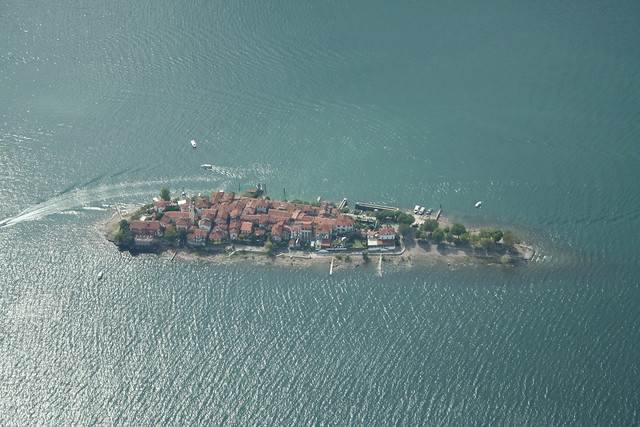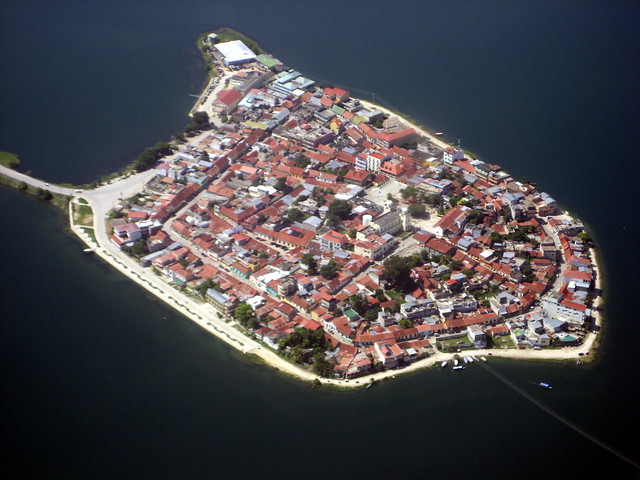Share Top 10 | A couple of weeks ago I wrote about the ultimate Robinson Crusoe feel on several uninhabited islands around the world. The islands listed in this post were also once uninhabited but after being settled became so heavily urbanized that the built-up areas eventually took over the entire island, forming
island cities.
10Lindau
The historic city Lindau is located near the meeting point of the Austrian, German and Swiss borders in the eastern part of Lake Constance (Bodensee). The city is connected with the mainland by bridge and railway and has about 3,000 inhabitants. Full of medieval and half-timbered buildings, the island city is quite a popular tourist attraction.
9Santa Cruz del Islote
 photo/ToluCaribe.com
photo/ToluCaribe.comLocated off the Caribbean coast of Colombia, Santa Cruz del Islote is unofficially the world’s most crowded island. It has some 90 houses and a population of around 1200 people crammed on an island of about 1 hectare. The islanders bury their dead in a nearby island because there is no space for a cemetery. They play football on the neighboring Mucura key, because the only public square on Santa Cruz is about half the size of a tennis court.
8Isola dei Pescatori
 flickr/_ Night Flier _
flickr/_ Night Flier _Isola dei Pescatori (Fishermen’s Island) is the most northerly of the three principal Borromean Islands in Lago Maggiore. With a population of about 50, it is the only one island to be inhabited all year round. A narrow street running along its spine is joined by cobbled alleys to the promenade which encircles the island. The promenade is frequently flooded and the houses built against it are constructed to allow for this. While the traditional occupation of fishing still exists, its picturesque charms has made tourism the most important source of income for the islanders.
7Mexcaltitan
 flickr/adam79
flickr/adam79Mexcaltitán is a small man-made island city off the Pacific coast of Mexico. The town sits low in the marshy, mangrove-lined channels that surround it, and during the June to October rainy season, water floods the streets and everyone rows from place to place in boats. Some experts believe that Mexcaltitán may actually be the legendary Aztlán, the ancestral homeland of the Aztec people. Today it’s foremost a shrimping town, with shrimps spread out to dry on any available surface throughout the town.
6Trogir
Located close to the city of Split, Trogir is one of the best preserved medieval towns in Europe. Tiny medieval streets wind through the enchanting island city revealing hidden restaurants and eye-catching galleries. A wide seaside promenade snakes around the town, culminating in a charming port full of sailboats. A pleasing blend of Romanesque and Gothic architecture, Trogir boasts a spectacular Venetian Cathedral of St. Lawrence, a town hall and a medieval fortress.
5Nesebar
 flickr/Boby Dimitrov
flickr/Boby DimitrovOften referred to as the “Pearl of the Black Sea”, Nesebar is a rich island city defined by more than three millennia of ever-changing history. The ancient part of the town is situated on a island connected to the mainland by a narrow man-made causeway, and it bears evidence of occupation by a variety of different civilizations over the course of its existence. Nesebar is sometimes said to be the town with the highest number of churches per capita and represent the rich architectural heritage of the Eastern Orthodox.
4Flores
 flickr/Javier Aroche
flickr/Javier ArocheFlores is a located on Lake Petén Itzá and connected to land by a causeway, on the other side of which lie the twin towns Santa Elena and San Benito. It was here, on the island of Flores, that the last independent Maya state held out against the Spanish conquerors. Their city, Noh Petén (literally “City Island”) was eventually destroyed in 1697 when the Spanish attacked by boats.
For many tourist, the main reason to visit Flores is its proximity to the famous Maya ruins of Tikal. But the island city itself is a great destination, filled with colonial, red-roofed buildings, narrow cobblestone streets, a historic church and many hotels and restaurants. Most will find that this island city is more than just a take-off point, but a memorable attraction in itself.
3Malé
 flickr/m o d e
flickr/m o d eMalé is the capital and most populous city in the Maldives. Over 100,000 people are crammed onto the small island. Since there is no surrounding countryside, all infrastructure has to be located in the city itself. Water is provided from desalinated ground water while electric power is generated in the city using diesel generators. Solid waste is transported to nearby islands, where it is used to fill in lagoons. The larger airport island nearby was built in this way.
2Manhattan
 flickr/meironke
flickr/meironkeManhattan is one of New York’s five boroughs and is what people most often think of when they picture New York City. Manhattan is actually a city island and includes most of the best known attractions in New York. The word “Manhattan” comes from the Lenape who inhabited the area before the Europeans and is translated as “island of many hills”. In 1625 the Dutch built a Fort on Manhattan Island, which marked the birth of New York City. Today Manhattan is one of the most densely populated island cities in the world, with a 2008 population of 1,634,795 people living in a land area of 59.47 km² (22.96 square miles).
1Venice
 photo: ellimac
photo: ellimacWorld famous for its canals, Venice is built on an archipelago of 117 islands which are connected by 455 bridges. In the old center, the canals serve the function of roads, and almost every form of transport is on water or on foot.
The island city is slowly sinking however and during the high tides in autumn and winter, the Piazza San Marco, the lowest area of the island, becomes totally flooded with water. Over the last 1,000 years, it has sunk by around 7 centimeters (2.8 inches) for every century, while recent reports have stated that in the last century alone, the city of Venice has lowered by around 24 centimeters (9.4 inches). This may have more to do with the rising of the sea levels in the Adriatic than with Venice sinking into its own foundations. One proposed solution is to lift the city to a greater height above sea level by pumping water into the soil underneath the island city.
 photo/ToluCaribe.com
photo/ToluCaribe.com flickr/_ Night Flier _
flickr/_ Night Flier _ flickr/adam79
flickr/adam79
 flickr/Boby Dimitrov
flickr/Boby Dimitrov flickr/Javier Aroche
flickr/Javier Aroche flickr/m o d e
flickr/m o d e flickr/meironke
flickr/meironke

Tidak ada komentar:
Posting Komentar